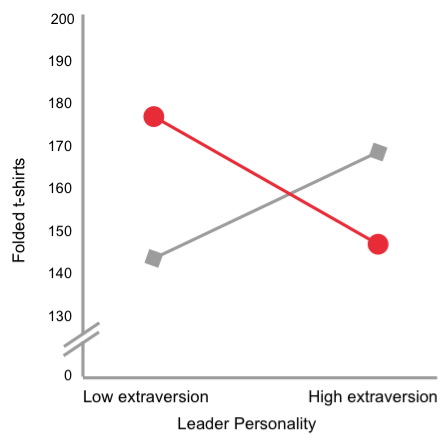Extraversion is (not) a condition for effective leadership

Several studies claim extraversion to be a sine qua non for effective leadership. Extraverted leaders are said to be more present and to achieve better results. The cause might be found in the societal perceptions of the typical extraverted features, such as high confidence and dominant behavior, to be typical leadership features. Consequently, extraverted individuals are attributed higher competencies which allows them to achieve more influence and a higher status among group members (Anderson & Kilduff, 2009).
The real difference between intro- and extraverts is proven by neuroscience. Social stimuli are processed differently, which leads to extraverts’ external focus and their need of more social interaction. Introverts’ focus is located on the inside, they need peace and quiet to charge their batteries.
Adam Grant, professor of the Wharton University, and his colleagues examined the actual difference in performance of teams led by intro- or extraverts (Grant, Gino & Hofmann, 2011). Their studies showed that the common assumption about extraverted leaders being more effective is not necessarily true. In two different experimental designs Grant et al. discovered that some teams indeed did show more productivity led by an extravert. But this was only true for passive teams. Proactive teams on the other hand significantly increased their productivity guided by an introverted leader. The researchers interpreted their findings by suggesting that introverted leaders leave more space for team members’ creative ways of problem-solving. Their extraverted colleagues might force their own opinions and working styles on the team members. This behavior complicates processes of creativity.
They gave different times ten minutes to fold as many t-shirts as possible. Proactive teams made creative suggestions to achieve better results. More passive teams rather adhered to their leader’s directives. The passive teams were more efficient with an extraverted leader but the proactive teams showed better results led by an introvert.

Figure: Grant, Gino & Hofmann, 2011, S. 541
This study leaves us with some questions regarding methodology, e.g. can you make universal statements about complex processes of group efficiency derived from a simple task such as folding jerseys? But the worth of introverted employees is not to be underestimated. The ”quiet” ones should also be considered to take on leadership positions and be promoted with well-directed personnel development measures. The aspect of leader and team fit is crucial. In times of innovation pressure and global collaboration proactive employees are essential for companies to remain competitive. Autonomy, initiative, and self-organization are key features in the current shift in values.

Several studies claim extraversion to be a sine qua non for effective leadership. Extraverted leaders are said to be more present and to achieve better results. The cause might be found in the societal perceptions of the typical extraverted features, such as high confidence and dominant behavior, to be typical leadership features. Consequently, extraverted individuals are attributed higher competencies which allows them to achieve more influence and a higher status among group members (Anderson & Kilduff, 2009).
The real difference between intro- and extraverts is proven by neuroscience. Social stimuli are processed differently, which leads to extraverts’ external focus and their need of more social interaction. Introverts’ focus is located on the inside, they need peace and quiet to charge their batteries.
Adam Grant, professor of the Wharton University, and his colleagues examined the actual difference in performance of teams led by intro- or extraverts (Grant, Gino & Hofmann, 2011). Their studies showed that the common assumption about extraverted leaders being more effective is not necessarily true. In two different experimental designs Grant et al. discovered that some teams indeed did show more productivity led by an extravert. But this was only true for passive teams. Proactive teams on the other hand significantly increased their productivity guided by an introverted leader. The researchers interpreted their findings by suggesting that introverted leaders leave more space for team members’ creative ways of problem-solving. Their extraverted colleagues might force their own opinions and working styles on the team members. This behavior complicates processes of creativity.
They gave different times ten minutes to fold as many t-shirts as possible. Proactive teams made creative suggestions to achieve better results. More passive teams rather adhered to their leader’s directives. The passive teams were more efficient with an extraverted leader but the proactive teams showed better results led by an introvert.

Figure: Grant, Gino & Hofmann, 2011, S. 541
This study leaves us with some questions regarding methodology, e.g. can you make universal statements about complex processes of group efficiency derived from a simple task such as folding jerseys? But the worth of introverted employees is not to be underestimated. The ”quiet” ones should also be considered to take on leadership positions and be promoted with well-directed personnel development measures. The aspect of leader and team fit is crucial. In times of innovation pressure and global collaboration proactive employees are essential for companies to remain competitive. Autonomy, initiative, and self-organization are key features in the current shift in values.
Sources

